Intel Z77 Motherboard Review with Ivy Bridge - ASRock, ASUS, Gigabyte, and MSI
by Ian Cutress on May 7, 2012 7:40 PM EST- Posted in
- Motherboards
- MSI
- Gigabyte
- ASRock
- Asus
- Ivy Bridge
- Z77
LAN Speed Test
LAN Speed Test is a freeware program designed for testing the network connection between two PCs on a home network. The speed of the transfer is limited by the lowest common denominator on the network, so if you have gigabit Ethernet capable computers but a 100 Mbit capable router, you are limited to 100 Mbit transfer. Note that this is really a formality – if a network port is rated at 1 Gbps, then chances are that it might hit at least 90+% of this value. The main test here is CPU usage, and how much is offloaded by the controller. For this test, we use LAN Speed Test to transfer a 1000 x 1 MB files across a home network with a 1 Gbps lowest common speed to the same machine each time, in a read/write scenario. Results are taken as peak speeds from several runs.
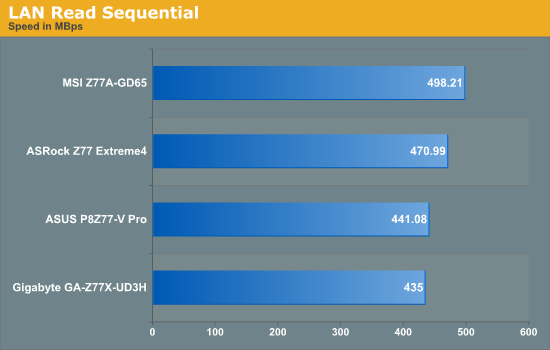
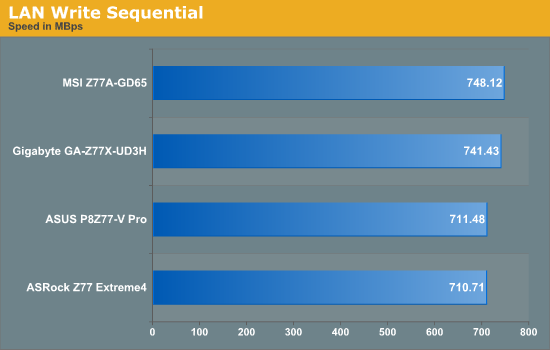
USB Speed
For this benchmark, we run CrystalDiskMark to determine the ideal sequential read and write speeds for the USB port using our 240 GB OCZ Vertex3 SSD with a SATA 6 Gbps to USB 3.0 converter. Then we transfer a set size of files from the SSD to the USB drive using DiskBench, which monitors the time taken to transfer. The files transferred are a 1.52 GB set of 2867 files across 320 folders – 95% of these files are small typical website files, and the rest (90% of the size) are the videos used in the Sorenson Squeeze test.
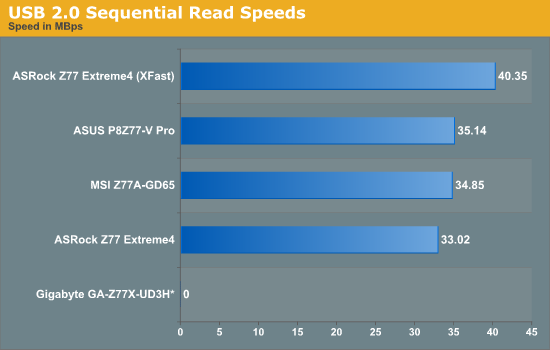
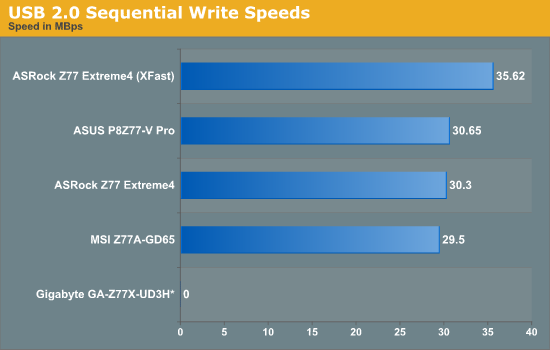
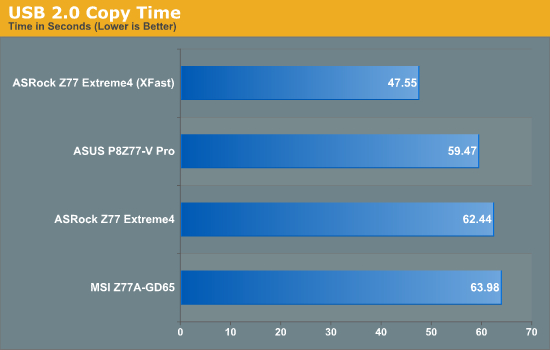
Due to the lack of Gigabyte USB 2.0 back panel ports, no results for the Gigabyte board were able to be fairly taken. In comparison, the XFast result from ASRock seems to speed ahead of the others.
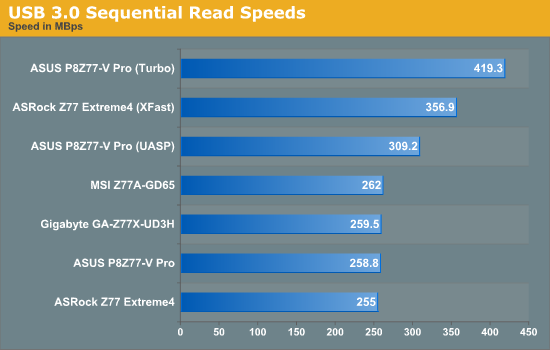
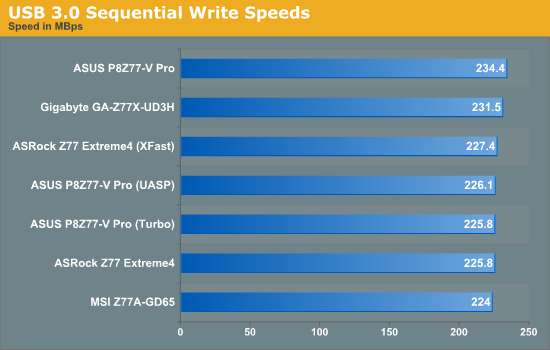
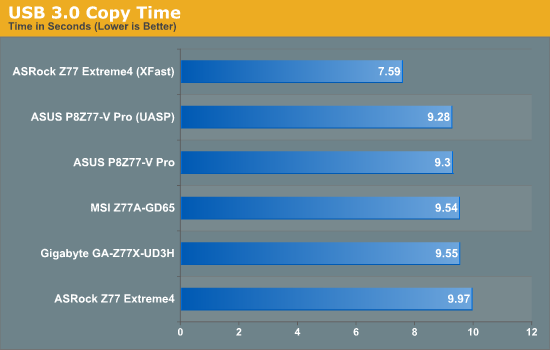
As this test deals with incompressible data at a Queue Depth of 1, UASP makes a difference in read but not in write. The adaptations performed by XFast are clear to see at this level.
SATA Testing
We also use CrystalDiskMark for SATA port testing on a C300 drive. The sequential test (incompressible data) is run at the 5 x 1000 MB level. This test probes the efficiency of the data delivery system between the chipset and the drive, or in the case of additional SATA ports provided by a third party controller, the efficiency between the controller, the chipset and the drive.
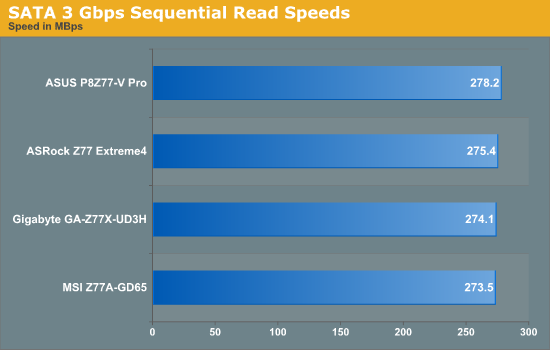
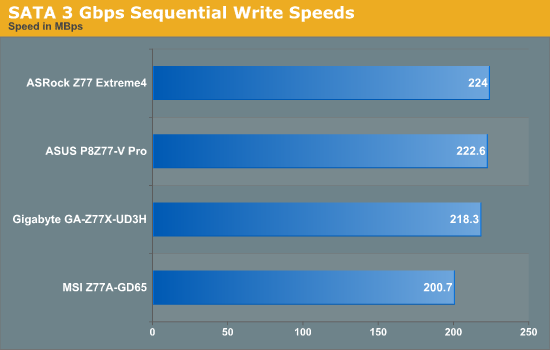

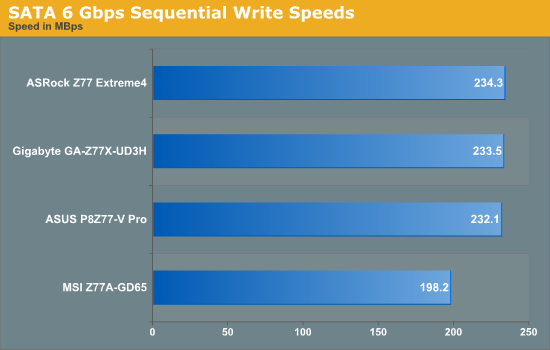
The MSI board seems to come out last in all our SATA testing.
DPC Latency
Deferred Procedure Call latency is a way in which Windows handles interrupt servicing. In order to wait for a processor to acknowledge the request, the system will queue all interrupt requests by priority. Critical interrupts will be handled as soon as possible, whereas lesser priority requests, such as audio, will be further down the line. Therefore, if the audio device requires data, it will have to wait until the request is processed before the buffer is filled. If the device drivers of higher priority components in a system are poorly implemented, this can cause delays in request scheduling and process time, resulting in an empty audio buffer – this leads to characteristic audible pauses, pops and clicks. Having a bigger buffer and correctly implemented system drivers obviously helps in this regard. The DPC latency checker measures how much time is processing DPCs from driver invocation – the lower the value will result in better audio transfer at smaller buffer sizes. Results are measured in microseconds and taken as the peak latency while cycling through a series of short HD videos - less than 500 microseconds usually gets the green light, but the lower the better.
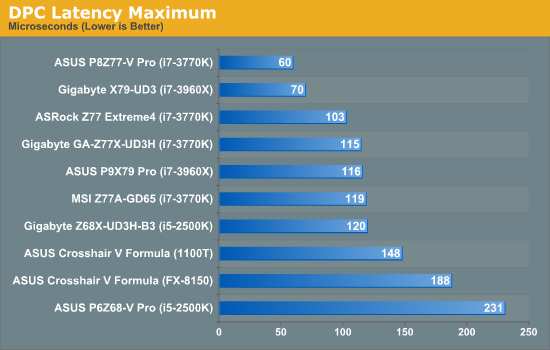
All the motherboards using Ivy Bridge chips do particularly well in our DPC test (as you would expect), with all boards coming in at under a very respectable 120 microseconds. The ASUS goes one step further with our lowest DPC score ever at 60 microseconds.










117 Comments
View All Comments
hasseb64 - Wednesday, May 9, 2012 - link
My last build was with a Z68 ATX MB, such a build will never happen again in my house. Next update will have Micro-ATX or maybe even a Mini-ATX.During my 15 years of computer building I have never used more than 1 GPU
In next computer I will probably not use any more expansion, today I have a old SB card installed.
And 2 slots for memory will do too (2x8 GB)
All HDDs are in separate WHS2011 box
ATX feels more and more like a thing of the past, these Taiwan makers are holding on as it seems but the future for them are to deliver smaller packages = less money.
ggathagan - Thursday, May 10, 2012 - link
For the vast majority of folks, you are correct, and the board manufacturers are also catering to that market.There are, however, plenty of people that *do* have multi-GPU systems.
Further, there are more uses for PCIe than just GPU's; RAID controllers, 10GbE NIC's, and high end sound cards, to name a few.
Zoomer - Tuesday, May 15, 2012 - link
To be honest, with GPUs these days, 7 slots seem to be not enough. 2 slots are needed for the GPU, 3 for semi-decent cooling, particularly for these darn open air coolers manufacturers like to use for some reason.Sysiphus - Wednesday, May 9, 2012 - link
Is it possible to control 3pin fans on this boards? I didnt see a option and the asus board has only 4pins. Chassisfans are normally 3pinned.kstan12 - Wednesday, May 9, 2012 - link
i own the asus p8z77-v pro. i have plugged my rear chassis & side panel fans into the 4 pin connectors on the mobo and i can control them with fan expert 2.i bought a few of these:
http://www.newegg.com/Product/Product.aspx?Item=N8...
Zoomer - Tuesday, May 15, 2012 - link
Can they be controlled via speedfan?mcquade181 - Thursday, May 10, 2012 - link
You can plug 3 pin fans into 4 pin MB connectors.ggathagan - Thursday, May 10, 2012 - link
Under the "ASRock Z77 Extreme4 - Overview" section you mention XFast USB twice.The second time should be XFast RAM
Under the "Visual Inspection" section for the MSI Z77A-GD65:
"Underneath this are the eight SATA ports - two SATA 6 Gbps from the PCH, four SATA 6 Gbps also from the PCH, and another two SATA 6 Gbps from an ASMedia controller."
I believe it should be "four SATA 3 Gbps also from the PCH...".
Under "Updates to our Testing Methodology"
"Also with experience allows us to pick tests ..."
Should be "Also, experience allows us to pick tests ..."
Under the conclusion section for the ASRock Z77 Exteme4:
"The XFast LAN software also shows superior performance in incompressible transfers or real-world transfers compared to standard USB throughput."
Should be "XFast USB software..."
All that aside, great review.
I appreciate the effort you and the rest of the Anandtech staff put in to improving your test processes.
I especially appreciate this multi-board approach that highlights the key differences across a series of boards that use the same chipset.
It certainly helps when making purchasing decisions.
Nickel020 - Thursday, May 10, 2012 - link
You say in the conclusion that you gain voltage read points by going withe MSI over the Gigabyte - the Gigabyte though does in fact also have voltage read points, just a less convenient implementationAs for the review: I realize that there are time constraints and you can't do one of the in-depth reviews that we sometimes got in the past, but I would like to see a more convenient user oriented layout, e.g. tables comparing the features of the boards, a table comparing the OC results etc. The way the review is structures i have to take a look at every board seperately, take notes and then compare them. Also some more comments on how the tested models compare to other models of the same manufacturers would be nice. Doesn't take much time, but greatly helps someone shopping around for a board.
Lastly, I'm highly skeptical of the software voltage readings but I know that many people do take such software readings as absolute truth, not realizing their potential flaws. You seem reasonably skeptical as well, and this is something I think should be mentioned in the review to prevent misunderstandings.
FozzyofAus - Thursday, May 10, 2012 - link
Hi guys,Any change you could review the:
AsRock z77 Professional-M
In addition to the previously requested:
AsRock z77 Extreme4-m
Thanks in advance,
Michael.